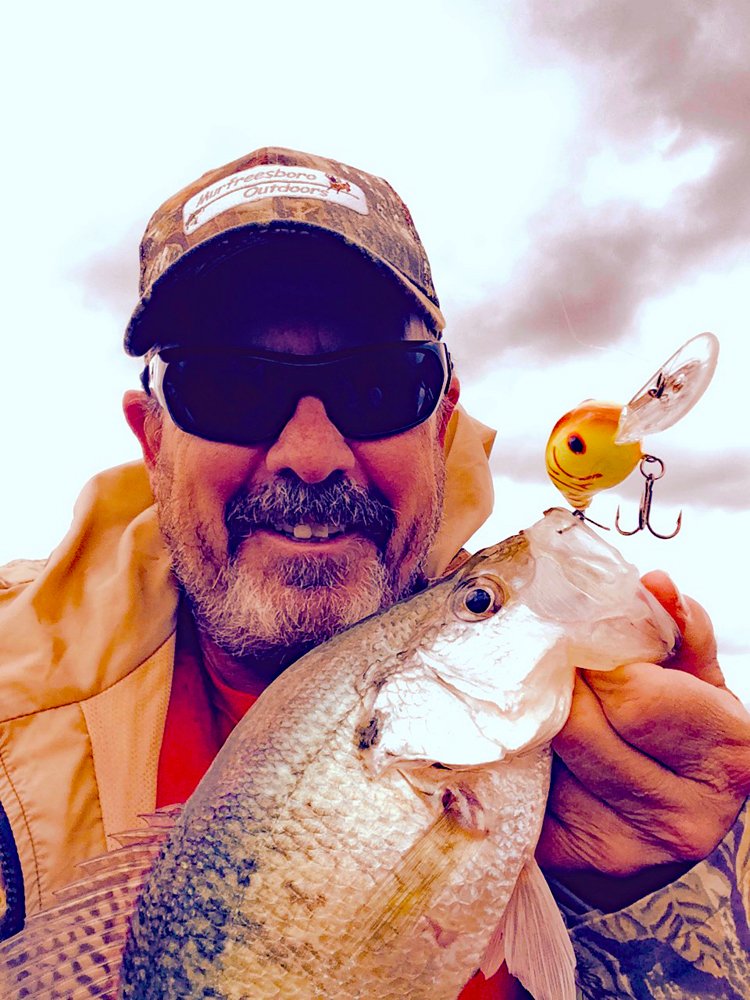Bob Latendresse shows us what Kentucky Lake offers anglers on a cold winter’s day. (Photo: Vernon Summerlin)
Crappies in Overcoats
by Vernon Summerlin
Detailed tips for popular Tennessee lake
Catching crappies in January can even be better than in the spring. They become tight-knit groups, more so than at other times of the year. The trick is locating them. Two Tennessee crappie guides give us tips on how to fish Kentucky Lake, a river-run impoundment on the Tennessee River, and Percy Priest Lake, a quite tributary reservoir.
Kentucky Lake
John Hunt of Waverly says, “You’ll need to fish from 10 to 25 feet deep along the creek channels in Kentucky Lake. The tightline rig or slip-float rig are about the only two ways to catch them. I suggest you use a small tuffy minnow this time of year.”

He says you can locate large schools of crappie in old creek channels.
“Use your sonar to locate where an eight-foot ledge that drops off to 20 or 25 feet. Crappies don’t require cover this time of year. They will hold on a steep drop out of the current and will school-up real tight. Once you locate them you can catch a lot of them.”
The important factor is current. Crappies won’t expend any more energy than necessary, especially in cold water because their metabolism is much slower and it takes longer for them to digest food for their needed energy.
“Most crappie are going to be out of the current off the main river. There is a good bit of current this time of year so they’ll be deep holding in the creek channel in the large embayments.”
John recommends you fish Bird Song, Cane and Leatherwood Creeks because they have deep water for wintertime fishing.
“A lot more people fish in January than they used to,” he concludes. “Some days you’d think it was spring with so many people out there.”
Percy Priest Lake
Harold Morgan of Nashville guided for crappies for more than 30 years on Percy Priest and knows it like the front of his boat. He’s placed more than 200 crappie “condos” so he can find fish all year long.
“Crappies don’t require cover this time of year. They will hold on a steep drop out of the current and will school-up real tight.” ~ Guide John Hunt

He says, “Crappies aren’t going to be roaming around the lake, they are going to be on the trees anywhere between 15 and 25 feet deep. I think the most productive places to fish are in coves or embayments where trees were left standing in 50 feet of water.
“To catch winter crappies, you need to use light line. Six-pound-test is good but four-pound-test is better. Use a number seven split shot or smaller and use a small minnow for bait. Crappie are dainty eaters in winter. If you want to use a jig tie on a 1/16-ouncer. It takes a while for it to sink 15 to 25 feet. I use plastic chartreuse bodies year-round but it depends on the color of the water.”
Harold says that January crappies are light hitters and you probably won’t feel them hit.
“When you see your line barely move, set the hook. Once a crappie hits your jig and you miss the hook set, it won’t give you another chance. You’ll have to entice another one to bite.
“This time of year, I fish the upper end. About the only place in the lower end you’ll find crappies is in Suggs Creek. I think it would be good to start at Hobson Pike Bridge and work up-lake to Bryant’s Grove, Fate Sanders, Spring Creek, Fall Creek and the West Fork of the Stones River. They are going to be where there is a little current carrying food. The lower end is mostly still. Crappies will move into shallower water on sunny days to about 10 feet deep in the backs of deep coves,” says Harold. “They won’t stay there at night, but you’ll find them from mid-morning until three or a little later in the afternoon. I’d try 10 feet deep on the flats in the deep coves. They won’t be on cover then because cover provides shade and they are looking for warm sunshine. The sun can warm the water as much as ten degrees during a sunny day. Minnows are active in the coves too, that’s another reason to fish there.”
Harold claims that during January you can expect to catch crappie from three-quarter-pound to one-pound with a few reaching the one and a half-pound range. His January catches usually number about 20 to 30 fish a day. One advantage to fishing in January is that the water level is stable when Priest is at winter pool, about 10 feet lower than summer pool. It’s a good time to take pictures of the cover that’s out of water because crappie will be in there come spring.
You know, of course, that crappies don’t wear overcoats but you probably should to take advantage of the tight-knit schools this winter.


